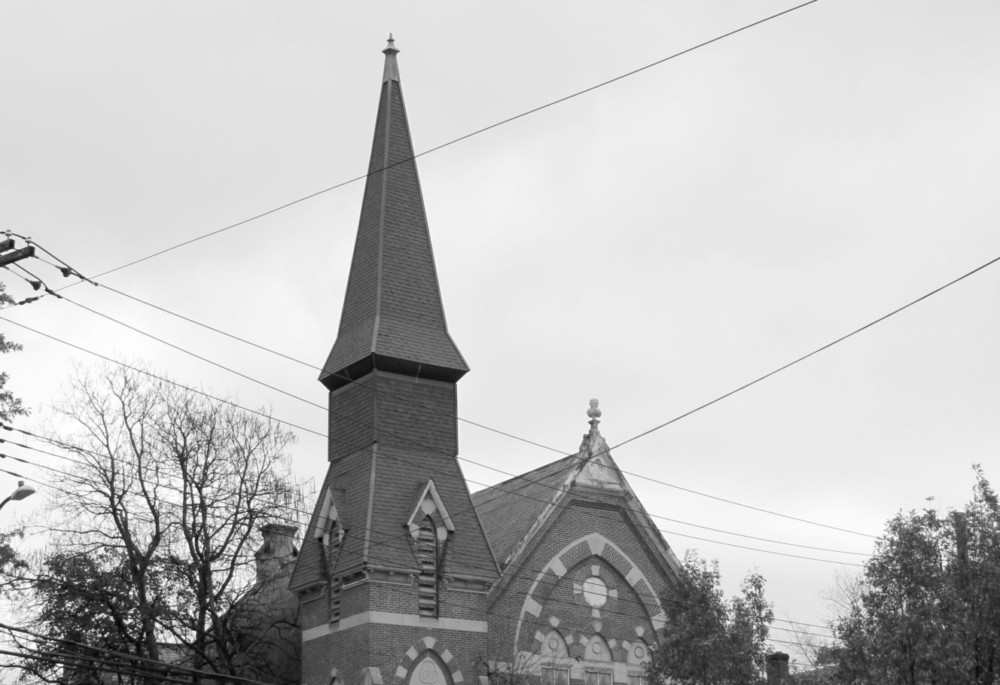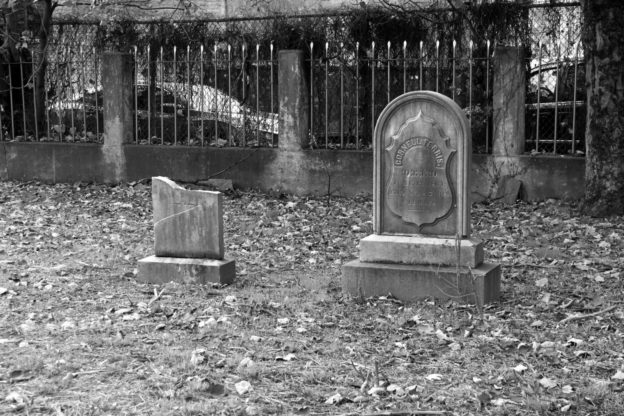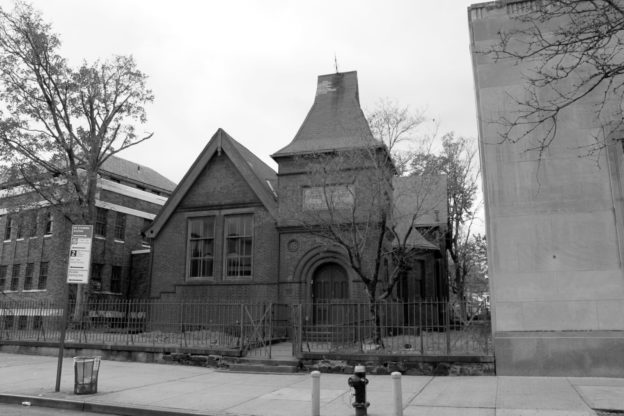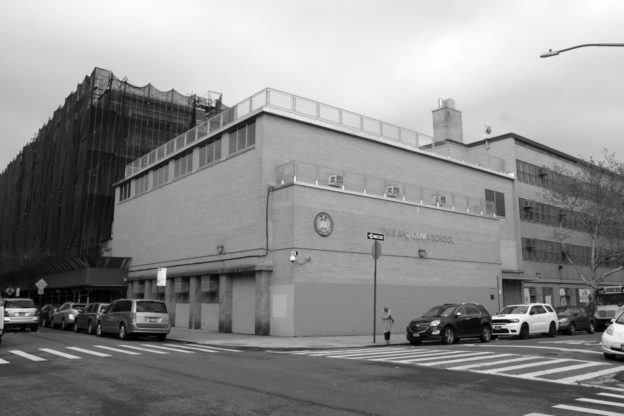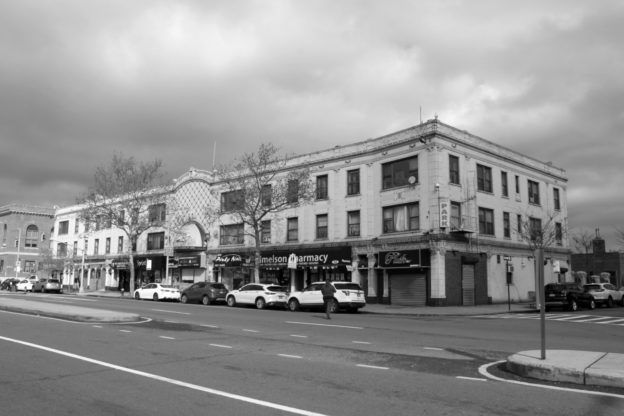3051 East Tremont Avenue
ca. 1880
This prominently sited brick church, designed in the High Victorian Gothic style, boasts a distinct steeple that can be seen from blocks away. Notably, Crow Hill, on which the church sits, was the site to which General William Howe and his troops retreated after being repulsed by American forces as they attempted to cross Westchester Creek. The use of polychromatic materials, such as the contrasting white stone trim and red brick, as well as the incorporation of banded arches into the facade, is emblematic of High Victorian Gothic architecture. The First Presbyterian Church of Throggs Neck was organized in the 1850s, and during the Civil War, church parishioners offered bowls of soup to soldiers passing through Throggs Neck via train so that they would not be tempted to visit nearby taverns. The congregation’s first structure burned down in 1870, and the date of current church is unknown, although some estimates date it to around 1880.
3000 East Tremont Avenue
1972
Eggers and Higgins
Straddling the Hutchinson River Parkway, this large public high school was designed by the firm of Eggers & Higgins as a creative response to a lack of adequate land and site constraints. The main academic building, rectangular in plan, is linked to the circular 1,000-seat auditorium by a three-story classroom wing that occupies the air rights above the parkway. The school is situated at the head of the once bustling Westchester Creek, which still sees some traffic in the form of houseboats and oil barges. Designed for a student body of 1,700, Lehman High was initially plagued by racial tension as the school’s population included students from white, Black and Puerto Rican neighborhoods. The school is aptly named after Herbert Lehman (1878-1963), who served as both a United States Senator and Governor of New York and was a tireless advocate for social programs and civil rights. Eggers & Higgins, a long-lasting firm comprised of partners Otto Eggers and Daniel Higgins, was involved in a variety of designs ranging from New York University’s redevelopment of the Washington Square Park area to Lincoln Center’s Guggenheim Bandshell.
Commerce Avenue
In use: 1700s – 1914
John Ferris, one of the five original recipients of the 1667 patent for the Township of Westchester, included provisions for a family burial ground in his 1717 will. The Ferris family used and maintained the cemetery for almost another two centuries until Charles Ferris passed away in 1908, leaving two vaults and around thirty gravestones to decay in an increasingly industrial setting. In 1928, the Benjamin Ferris family vault was vandalized and desecrated, prompting reinterment of almost half the bodies to Kenisco Cemetery in Westchester County. Through the ensuing decades, the cemetery has seen both periodic neglect and restoration, including the installation of a new fence in the early 2000s. Notable members of the Ferris family include James Ferris, who survived a stay on a British prison ship during the Revolutionary War and his wife, Charity Ferris, who purportedly housed British Admiral Richard Howe and transmitted strategically significant conversations to General George Washington. Whereas much of the Westchester Square was once farmlands of the Ferris family, nearby Ferris Place is the only surviving reminder in The Bronx of one of the borough’s earliest settlers.
9 Westchester Square
1882-83, Frederick Clarke Withers; Addition, 1890-92, William Anderson
The Huntington Free Library and Reading Room is one of the earliest instituions on Westchester Square and was the first library building in this part of The Bronx. The original building was designed by Frederick Clarke Withers and completed in 1883. Born and educated in England, Withers became known for his Victorian Gothic designs, epitomized by his 1874 Jefferson Market Courthouse in Greenwich Village. Commissioned by the executors of the estate of tobacco merchant Peter C. Van Shaick, who left $15,000 for the construction of a free reading room for Westchester and in honor of his wife, Anna Mitchell Van Shaick, who died in 1876. The building sat vacant after the town government refused to accept the gift due to its limited endowment. In 1890, Collis Potter Huntington, a railroad magnate with a summer home in nearby Throggs Neck purchased the building, expanded it, and endowed it with funds to cover its operating expenses. The building is entered through an arched doorway set within a one-bay tower, which features a terra cotta plaque and rondels that commemorate Huntington’s donation. The Huntington Free Library was designated as a NYC Individual Landmark in 1994 as the “Van Shaick Free Reading Room / Huntington Free Library and Reading Room”.
12 Westchester Square
1942
Cross & Cross
Originally a Federal Revival style building, in 1940 architects Cross & Cross updated the structure to relfect the latest architectural fashion of the time. The architects employed stylized classical elements such as a sawtoothed balustrade and fluted pilasters which flank the entrance in a Streamline Moderne expression. A integral clock adorns the facade, with gemoetric shapes in place of numbers set within carved ribbing. This edifice still features its original name — The Bronx Savings Bank — carved into stone beneath the contemporary Apple Bank for Savings signage that currently exists. A local banking institution, The Bronx Savings Bank operated from 1905 until 1974, which branches throughout The Bronx and Westchester County.Cross & Cross were a prolific firm who designed many distinguished Art Deco skyscrapers such as the General Electric Building, Twenty Exchange Place and 90 Church Street, all in Manhattan.
2555 Tratman Avenue
1966; 1910 Annex
Although its current home was constructed in 1966, Public School 12’s history stretches back to include at least three buildings in the vicinity of Westchester Square. The first PS 12, replete with a spire-topped tower, was completed in 1886 and stood at the current site of the playground on Frisby Avenue. A later addition to the original structure, built around 1910, was designed in the Renaissance Revival style and still stands as an office annex connected to the four-story, yellow-brick Modern style classroom building, built in 1966. This building was the city’s first school building purpose-built for the specialized education of students with behavioral issues. This building is divided into two architectural components: the corner portion, which features minimal fenestration, blank brick walls, and the school entrance; and the classroom wing, with the upper three stories characterized by contrasting bands of windows and panels. Interestingly, one of PS 12’s most beloved and longest-serving principals, Dr. John Condon, made headlines in 1932 as the designated intermediary between Charles Lindbergh and the kidnappers of his child.
2626 East Tremont Avenue
ca. 1912
This three-bay, three-story building features a limestone facade and pedimented entryway. The building was originally constructed as the Wyoming Masonic Temple to host the local Wyoming Lodge of the Free & Accepted Masons (“Freemasons”). Legend holds that as a Westchester Lodge already existed, members selected the name “Wyoming” after randomly pulling a bank note issued by the Pennsylvania-based Bank of Wyoming. While the exact date of construction is unknown, the Wyoming Masonic Temple is referenced as a venue for Freemasons as early as 1912. Historic photographs demonstrate that while the Freemasons consistently occupied the upper floors of the building, the ground floor space was rented to a range of tenants over the years. With international roots that stretch back centuries, the Free & Accepted Masons is a fraternal organization that focuses on civic engagement, which is demonstrated by the variety of community events advertised at the Wyoming Masonic Temple over its long history. Of the seven masonic temples that originally served The Bronx, six remain standing. Only the City Island Temple retains its original function, housing the Wyoming Lodge along with the three other lodges currently active in the borough.
44 Westchester Square
ca. 1921
Known locally as “The White Elephant,” this three-story white brick structure stretches the entire length of a prominent block. The monochrome brick is complemented by a striking variety of multicolored glazed terra cotta, including a band above the first floor retail fenestration and diamond patterning that covers the entirety of the facade above the building’s main entrance. Interestingly, the central archway, now occupied by a retail storefront, once opened inward to feature a round arched hallway lined with tilework. Although this structure never served as a theater, one may infer the building’s intended use from the terra-cotta detailing, which includes representations of theatrical masks and instruments. The White Elephant has hosted a variety of tenants over its long history, including cafes, realtors and an office of The Bronx Gas & Electric Company.
Lane Avenue & Westchester Square
1925, John Oakman
Dedicated in 1925 and relocated to this spot in the early 1940s, this fifteen-foot-high pink granite monument was donated by the “people of Westchester” to honor local residents who served in World War I. This monument takes the form of a pylon: It is rectangular in plan, grounded on a plinth and tapering in tiers to culminate with a cornice. The memorial carries the inscription: “To perpetuate in grateful remembrance the sacrifice, heroism, and devotion of the men and women of the old town of Westchester who in the World War answered the call of their country that justice and righteousness should not perish.” Along with listing the names of soldiers who died in the war, the monument carries the names of the battles in which they perished, including the Battles of Cambrai, the Somme, and Vittorio Veneto, among others. Owen F. Dolen, a local educator who led the six-year initiative to construct the monument, gave a twenty-five minute speech at its dedication ceremony before suddenly dying of a heart attack minutes later. This monument is one of 103 memorials in New York City parks dedicated to those that served in World War I.
